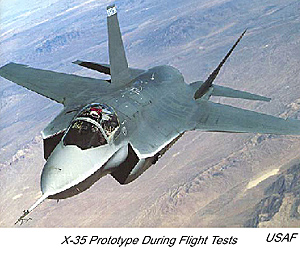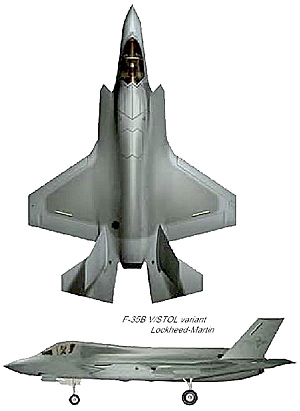 The UK wants to buy 150 aircraft that will be operated jointly by the RN and the RAF. They haven’t decided
whether they will order the V/STOL or CV variant yet. It has to be capable of operating off their new carrier.
The UK wants to buy 150 aircraft that will be operated jointly by the RN and the RAF. They haven’t decided
whether they will order the V/STOL or CV variant yet. It has to be capable of operating off their new carrier.
Many other countries are involved in the program as potential purchasers, including Canada, Denmark, Norway, the Netherlands, Italy, Singapore, Tu rkey, and Israel. Even if the huge numbers desired by the services are scaled back, because of international sales the JSF/F-35 program may become the biggest aircraft manufactur-ing program since the F-16.
On all aircraft, the payload can be carried in two parallel internal bays in the fuselage. These are the same size on all three versions, but only the A and C variants will have the bulged doors that allow them to carry larger weapons in the 2000 lb class. Because of weight limitations, the B will only carry 1000-lb weapons.
All the variants can carry one AIM-120 AMRAAM on the inside of each bay door. The plane can also be fitted with four hard-points under the wings for ordnance and wingtip stations (A&B) or a third underwing station (C) for IR AAMs. The two inner wing hardpoints will be wet, allowing up to four drop tanks to be carried.
Obviously carrying ordnance under the wings increases the signature, but they could be used for drop tanks discarded before the plane reaches a high-threat area, or for standoff missiles that don’t require penetrating heavy defenses, or for decoys. The inner wing hardpoints are rated at 2270 kg, while outers can carry 1135 kg. This means they could each carry substantial air-to-ground stores. The F-35 will be able to carry the full range of Air Force air-to-ground weapons, including Paveway and GBU-series laser-guided weapons, the GBU-F-35B V/STOL variant Lockheed-Martin.
In October of 2001, Lockheed-Martin’s X-35 was chosen as the winner of the Joint Strike Fighter (JSF) competition. Assigned the designation F-35, it will enter service in 2010, eighteen years after the program’s creation in 1992.
It’s stealthy, like the F-117, but in the same size and performance class as the F-16. Unlike the F-16, it will have a full range of air-to-ground sensors, allowing it to fly attack missions under any conditions. It’s also a lot more maintainable than the F-117 and B-2 with their “first-gen” stealth materials. There will be several variants. The simplest will be the Air Force’s F-35A. It is a conventional-takeoff aircraft, and the USAF wants 1700 of them to replace the A-10 and F-16. Like the F-15 and F-16, the F-22 and F-35 will be partners, one handling air superior-ity while the other attacks ground targets. I wouldn’t call it a “high-low mix.”
The F-35B is the USMC version and will be the first to enter service. It is V/STOL, using a geared lift fan. It will not have a gun, but it can take off and hover, and retains super-sonic performance. The USMC wants 480 to replace the F/A-18 and the AV-8B.
The US Navy will operate a “CV” F-35C variant with larger airfoils. The wings will fold, but because they are larger it will also have more fuel and a greater payload. It will have twice the range of the F/A-18C on internal fuel. The internal structure and landing gear is strengthened to deal with the shock of carrier landings, and of course there’s a tail hook. The Navy wants 480 of them. It will also not have a gun, but it will be stealthier than the other two variants, and will also be the most 31/32 JDAM and AGM-154 JSOW. Navy aircraft will be able to carry SLAM-ER externally.
The only air-to-air weapons discussed for the F-35 so far are the AMRAAM and Sidewinder. It has a limited air-to-air capability, which is reasonable given its F-22 partner. The UK version will operate with a mix of US and British weapons. It will be cleared for Meteor, ASRAAM, Brimstone, and Storm Shadow.
The Air Force will be the only variant with a gun, a single Mauser 27mm now carried on the Tornado and other European aircraft. To save weight the B and C will not have an internal gun, but will be able to carry an external gun pod, but what this will do to its signature is unknown. They haven’t released a lot of performance information yet. Unrefueled range is probably near 2000 nm, based on a published combat radius of 600 nm. It’s not as fast as the F-22, maxing out at Mach 1.5 instead of Mach 2.2, but it can “supercruise,” barely. Its performance is still fine for an attack aircraft (so why doesn’t it have an “A” designation?) And it will still be a formidable air-to-air opponent. There’s no HUD. Instead a helmet-mounted display will allow the pilot to aim AAMs just by turning his head. Presumably it will also simplify air-to ground ordnance delivery.
It has the same radar as the F-22, the APG-77 AESA. This is a ”low probability of intercept” radar with imaging capability. It won’t have as long a range as the model in the F-22 because they can’t mount as many antenna elements on the skin. Max range against a large aircraft will be 90 nm. The radar is integrated with the EW and ESM suite, and the plane also has an IRST, FLIR, low-light EO sensor, laser spot tracker, and laser designator as standard equipment. The specifications provided on this page are for players who don’t want to wait for 2010. The performance is estimated, and there will be many more ordnance loadouts than the ones listed there.
It doesn’t have a name yet.
 F-35A Fighter
F-35A Fighter
Gun Atk: 4
Man Rtg: 5.0/3.5
Size: Small
Signature: Stealthy
Counterm: 4th Gen J&D
Bombsight: Advanced
Sensors: APG-77 AESA multifunction radar, helmet-mounted
display, 3rd Gen FLIR, 3rd Gen ESM, laser spot tracker, laser designator.
Performance:
| Speed in Knots (Nm/Phase) Throttle Setting | |||
|---|---|---|---|
| Altitude | Cruise | Full Mil | Reheat |
| V/Low: | 460 (1.9) | 590 (2.5) | 790 (3.3) |
| Med: | 520 (1.9) | 640 (2.7) | 830 (3.5) |
| High: | 580 (1.9) | 690 (2.9) | 870 (3.6) |
Ceiling: 15240 m
Engine Type: TF
Inflight Refuel: Y
Endurance Data
Cruise Range: 1910 nm
Internal Fuel: 8309 kg
Drop Tank Desc. Fuel Wt. Range Add.
600 USG drop tank 1854 kg 425 nm
Payload: 5900 kg
Ordnance Loadouts:
Off Guns: 1 BK27 27mm
2 AIM-120 AMRAAM and 2 GBU-31 JDAM (Internal)
2 AIM-120 AMRAAM and 2 AGM-142 JSOW (Internal)
Remarks: USAF variant.
F-35B Fighter
Gun Atk: --
Man Rtg: 5.0/3.5
Size: Small
Signature: Stealthy
Counterm: 4th Gen J&D
Bombsight: Advanced
Sensors: Same as F-35A
Performance: Speed in Knots (Nm/Phase)
| Speed in Knots (Nm/Phase) Throttle Setting | |||
|---|---|---|---|
| Altitude | Cruise | Full Mil | Reheat |
| V/Low: | 460 (1.9) | 590 (2.5) | 790 (3.3) |
| Med: | 520 (1.9) | 640 (2.7) | 830 (3.5) |
| High: | 580 (1.9) | 690 (2.9) | 870 (3.6) |
Ceiling: 15240 m
Engine Type: TF
Inflight Refuel: Y
Endurance Data
Cruise Range: 1565 nm
Internal Fuel: 6802 kg
Drop Tank Desc. Fuel Wt. Range Add.
600 USG drop tank 1854 kg 425 nm
Payload: 5900 kg
Ordnance Loadouts:
External gun pod
2 AIM-120 AMRAAM and 2 GBU-32 JDAM (Internal)
2 AIM-120 AMRAAM and 2 AGM-142 JSOW (Internal)
Remarks: USMC and UK variant.
F-35C Fighter
Gun Atk: --
Man Rtg: 5.0/3.5
Size: Small
Signature: Stealthy
Counterm: 4th Gen J&D
Bombsight: Advanced
Sensors: Same as F-35A
Performance:
| Speed in Knots (Nm/Phase) Throttle Setting | |||
|---|---|---|---|
| Altitude | Cruise | Full Mil | Reheat |
| V/Low: | 460 (1.9) | 590 (2.5) | 790 (3.3) |
| Med: | 520 (1.9) | 640 (2.7) | 830 (3.5) |
| High: | 580 (1.9) | 690 (2.9) | 870 (3.6) |
Ceiling: 15240 m
Engine Type: TF
Inflight Refuel: Y
Endurance Data
Cruise Range: 2000 nm
Internal Fuel: 8689 kg
Drop Tank Desc. Fuel Wt. Range Add.
600 USG drop tank 1854 kg 425 nm
Payload: 7715 kg
Ordnance Loadouts:
External gun pod
2 AIM-120 AMRAAM and 2 GBU-31 JDAM (Internal)
2 AIM-120 AMRAAM and 2 AGM-142 JSOW (Internal)
Remarks: USN carrier variant.
BT
Back to The Naval Sitrep #22 Table of Contents
Back to Naval Sitrep List of Issues
Back to MagWeb Master Magazine List
© Copyright 2002 by Larry Bond and Clash of Arms.
This article appears in MagWeb (Magazine Web) on the Internet World Wide Web.
Other military history and related articles are available at http://www.magweb.com